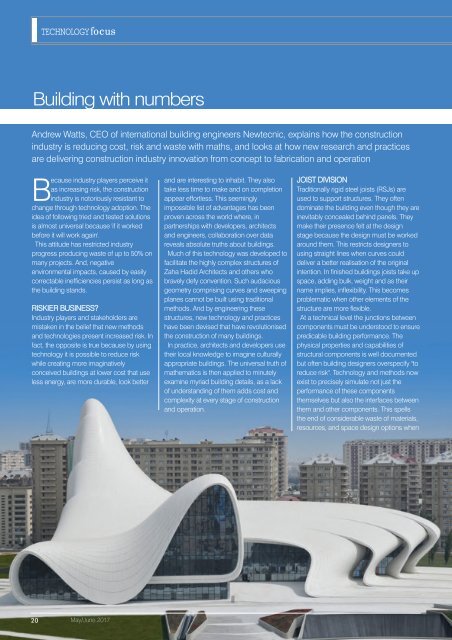Create successful ePaper yourself
Turn your PDF publications into a flip-book with our unique Google optimized e-Paper software.
TECHNOLOGY focus<br />
Building with numbers<br />
Andrew Watts, CEO of international building engineers Newtecnic, explains how the construction<br />
industry is reducing cost, risk and waste with maths, and looks at how new research and practices<br />
are delivering construction industry innovation from concept to fabrication and operation<br />
Because industry players perceive it<br />
as increasing risk, the construction<br />
industry is notoriously resistant to<br />
change through technology adoption. The<br />
idea of following tried and tested solutions<br />
is almost universal because 'if it worked<br />
before it will work again'.<br />
This attitude has restricted industry<br />
progress producing waste of up to 50% on<br />
many projects. And, negative<br />
environmental impacts, caused by easily<br />
correctable inefficiencies persist as long as<br />
the building stands.<br />
RISKIER BUSINESS?<br />
Industry players and stakeholders are<br />
mistaken in the belief that new methods<br />
and technologies present increased risk. In<br />
fact, the opposite is true because by using<br />
technology it is possible to reduce risk<br />
while creating more imaginatively<br />
conceived buildings at lower cost that use<br />
less energy, are more durable, look better<br />
and are interesting to inhabit. They also<br />
take less time to make and on completion<br />
appear effortless. This seemingly<br />
impossible list of advantages has been<br />
proven across the world where, in<br />
partnerships with developers, architects<br />
and engineers, collaboration over data<br />
reveals absolute truths about buildings.<br />
Much of this technology was developed to<br />
facilitate the highly complex structures of<br />
Zaha Hadid Architects and others who<br />
bravely defy convention. Such audacious<br />
geometry comprising curves and sweeping<br />
planes cannot be built using traditional<br />
methods. And by engineering these<br />
structures, new technology and practices<br />
have been devised that have revolutionised<br />
the construction of many buildings.<br />
In practice, architects and developers use<br />
their local knowledge to imagine culturally<br />
appropriate buildings. The universal truth of<br />
mathematics is then applied to minutely<br />
examine myriad building details, as a lack<br />
of understanding of them adds cost and<br />
complexity at every stage of construction<br />
and operation.<br />
JOIST DIVISION<br />
Traditionally rigid steel joists (RSJs) are<br />
used to support structures. They often<br />
dominate the building even though they are<br />
inevitably concealed behind panels. They<br />
make their presence felt at the design<br />
stage because the design must be worked<br />
around them. This restricts designers to<br />
using straight lines when curves could<br />
deliver a better realisation of the original<br />
intention. In finished buildings joists take up<br />
space, adding bulk, weight and as their<br />
name implies, inflexibility. This becomes<br />
problematic when other elements of the<br />
structure are more flexible.<br />
At a technical level the junctions between<br />
components must be understood to ensure<br />
predicable building performance. The<br />
physical properties and capabilities of<br />
structural components is well documented<br />
but often building designers overspecify "to<br />
reduce risk". Technology and methods now<br />
exist to precisely simulate not just the<br />
performance of these components<br />
themselves but also the interfaces between<br />
them and other components. This spells<br />
the end of considerable waste of materials,<br />
resources, and space design options when<br />
20<br />
May/June 2017

















